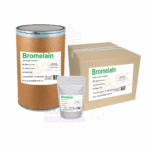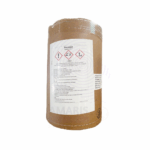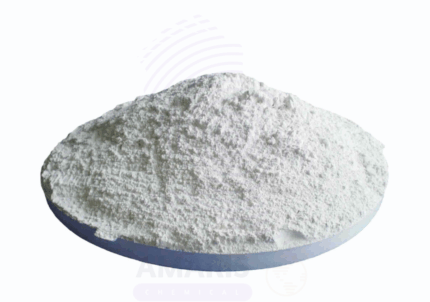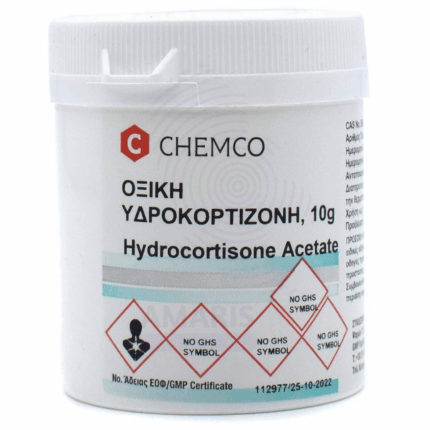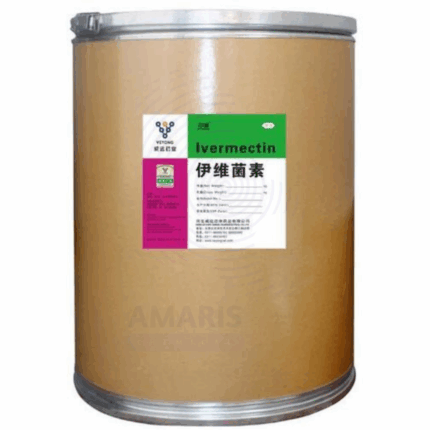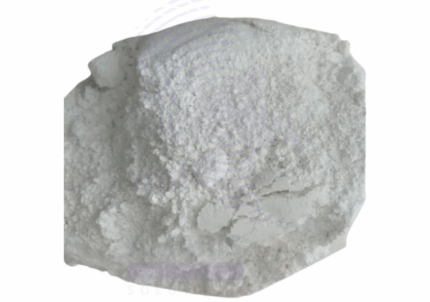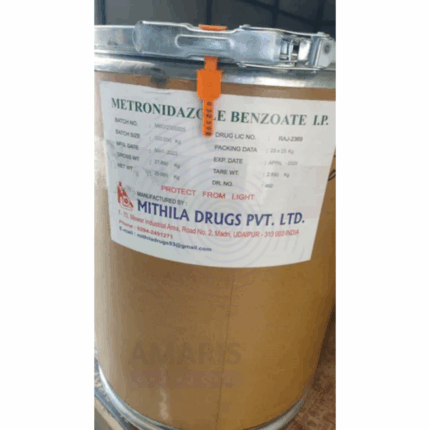Bromhexine HCL BP
Bromhexine HCL BP is a synthetic mucolytic agent, commonly used as an expectorant to treat respiratory disorders associated with excessive mucus. It appears as a white or slightly yellow crystalline powder that is soluble in water and alcohol. Bromhexine works by breaking down the structure of mucus, reducing its viscosity and facilitating easier expectoration. It is widely used in pharmaceutical formulations such as tablets, syrups, and injectables for respiratory conditions like bronchitis, asthma, and chronic obstructive pulmonary disease (COPD).
Bromhexine HCL BP
Primary Uses
- Pharmaceuticals
- Used as a mucolytic agent to liquefy and reduce the viscosity of sputum in patients with respiratory tract diseases.
- Formulated in oral tablets, syrups, and injectables to treat bronchitis, chronic obstructive pulmonary disease (COPD), asthma, and other mucus-related respiratory conditions.
- Enhances the effectiveness of antibiotics by improving mucus clearance.
- Medical & Clinical
- Used as an adjunctive therapy in respiratory infections to aid mucus clearance.
- Sometimes combined with other bronchodilators and anti-inflammatory agents for improved respiratory function.
Secondary Uses
- Veterinary Medicine
- Occasionally used in veterinary formulations to treat respiratory conditions in animals involving mucus accumulation.
- Research
- Utilized in pharmacological studies investigating mucolytic and respiratory therapies.
1. Basic Identification Attributes
- Chemical Name (IUPAC): trans-4-(2-Amino-3,5-dibromobenzyl)morpholine hydrochloride
- Common/Trade Name: Bromhexine Hydrochloride, Bromhexine HCL BP
- CAS Number: 611-75-6
- HS Code: 2933.39.00
- Molecular Formula: C14H20Br2N2O · HCl
- Synonyms:
- Bromhexine hydrochloride BP
- Bisolvon (brand name)
- Bromhexol hydrochloride
2. Physical & Chemical Properties
- Physical State: Crystalline powder
- Color & Odor: White or slightly yellow; odorless or faint characteristic odor
- Melting Point: 208–212°C (with decomposition)
- Boiling Point: Not applicable (decomposes)
- Density: Approx. 1.55 g/cm³
- Solubility: Freely soluble in water, sparingly soluble in ethanol, slightly soluble in chloroform
- pH: Acidic due to hydrochloride salt, pH ~3–4 in aqueous solution
- Stability: Stable under normal conditions; sensitive to moisture and light
3. Safety & Hazard Attributes
- Hazard Class (GHS): Not classified as hazardous under normal handling; mild irritant
- NFPA Ratings:
- Health: 1
- Flammability: 0
- Reactivity: 0
- Exposure Limits: No specific OSHA/ACGIH limits; avoid dust inhalation
- Toxicity: Low acute toxicity; overdose may cause gastrointestinal discomfort and CNS effects
- Reactivity: Stable; avoid strong oxidizing agents
4. Storage & Handling Attributes
- Storage Conditions: Store in a cool, dry place protected from light and moisture
- Container Type: Airtight containers such as HDPE or glass bottles
- Shelf Life: Typically 3–5 years if stored properly
- Special Handling: Use PPE when handling powder; avoid inhalation and prolonged skin contact
5. Regulatory & Compliance Attributes
- Pharmacopoeia Compliance: Complies with British Pharmacopoeia (BP) standards
- FDA Status: Approved for medicinal use in many countries as a prescription mucolytic agent
- Transportation: Not classified as hazardous
- Waste Disposal: Dispose according to pharmaceutical waste regulations
6. Environmental & Health Impact
- Ecotoxicity: Low; no significant environmental hazard reported
- Persistence: Organic compound; biodegrades under aerobic conditions
- Bioaccumulation: Not expected to bioaccumulate
- Carcinogenicity/Mutagenicity: Not classified as carcinogenic or mutagenic
- Biodegradability: Biodegradable in the environment
Safety Handling Precautions
Personal Protective Equipment (PPE):
- Gloves
- Protective goggles
- Dust mask or respirator (when handling powder)
- Lab coat or protective clothing
Handling Measures:
- Avoid inhalation of dust and skin contact
- Work in well-ventilated areas
- Use local exhaust ventilation if dust is generated
Storage Measures:
- Keep container tightly closed
- Protect from moisture and direct sunlight
Hygiene Practices:
- Wash hands thoroughly after handling
- Do not eat, drink, or smoke while handling
First Aid Measures
- Inhalation: Move to fresh air; seek medical attention if respiratory symptoms occur
- Skin Contact: Wash with soap and water; seek medical advice if irritation develops
- Eye Contact: Rinse thoroughly with water for at least 15 minutes; seek medical advice if irritation persists
- Ingestion: Rinse mouth; seek medical attention if large amounts ingested or if adverse symptoms occur
Firefighting Measures
- Fire Hazards: Non-flammable
- Extinguishing Media: Use water spray, foam, dry chemical, or CO₂ depending on surrounding fire
- Special Precautions: Firefighters should wear full protective gear and SCBA if needed
- Decomposition Products: May produce toxic gases including hydrogen chloride under extreme heat
Related products
Chlorpheniramine Maleate
Diloxanide Furoate
Hydrocortisone Acetate
Ivermectin BP Vet
Mebendazole USP ( Micronized white)
Methyl Salicylate BP
Metronidazole Benzoate BP
Miconazole Nitrate BP
Miconazole Nitrate BP is a high-purity, pharmaceutical-grade antifungal agent conforming to British Pharmacopoeia (BP) specifications. It is widely used in the formulation of topical and oral pharmaceutical products for the treatment of fungal infections caused by dermatophytes and yeasts, including Candida species. Miconazole Nitrate functions by inhibiting the biosynthesis of ergosterol, a vital component of fungal cell membranes, leading to cell death.
This white to off-white crystalline powder is highly effective and exhibits broad-spectrum antifungal and some antibacterial activity. It is commonly utilized in creams, ointments, powders, and gel formulations.


 Preservatives(food)
Preservatives(food) Flavor Enhancers
Flavor Enhancers Acidulants
Acidulants Sweeteners
Sweeteners Antioxidants
Antioxidants Colorants(food)
Colorants(food) Nutraceutical Ingredients (food)
Nutraceutical Ingredients (food) Nutrient Supplements
Nutrient Supplements Emulsifiers
Emulsifiers
 Collectors
Collectors Dust Suppressants
Dust Suppressants Explosives and Blasting Agents
Explosives and Blasting Agents Flocculants and Coagulants
Flocculants and Coagulants Frothers
Frothers Leaching Agents
Leaching Agents pH Modifiers
pH Modifiers Precious Metal Extraction Agents
Precious Metal Extraction Agents
 Antioxidants(plastic)
Antioxidants(plastic) Colorants (Pigments, Dyes)
Colorants (Pigments, Dyes) Fillers and Reinforcements
Fillers and Reinforcements Flame Retardants
Flame Retardants Monomers
Monomers Plasticizers
Plasticizers Polymerization Initiators
Polymerization Initiators Stabilizers (UV, Heat)
Stabilizers (UV, Heat)
 Antifoaming Agents
Antifoaming Agents Chelating Agents
Chelating Agents Coagulants and Flocculants
Coagulants and Flocculants Corrosion Inhibitors
Corrosion Inhibitors Disinfectants and Biocides
Disinfectants and Biocides Oxidizing Agents
Oxidizing Agents pH Adjusters
pH Adjusters Scale Inhibitors( water)
Scale Inhibitors( water)
 Antioxidants(cosmetic)
Antioxidants(cosmetic) Emollients
Emollients Fragrances and Essential Oils
Fragrances and Essential Oils Humectants
Humectants Preservatives
Preservatives Surfactants(cosmetic)
Surfactants(cosmetic) Thickeners
Thickeners UV Filters
UV Filters
 Fertilizers
Fertilizers Soil Conditioners
Soil Conditioners Plant Growth Regulators
Plant Growth Regulators Animal Feed Additives
Animal Feed Additives Biostimulants
Biostimulants Pesticides (Herbicides, Insecticides, Fungicides)
Pesticides (Herbicides, Insecticides, Fungicides)
 Active Pharmaceutical Ingredients (APIs)
Active Pharmaceutical Ingredients (APIs) Excipients
Excipients Solvents(pharmaceutical)
Solvents(pharmaceutical) Antibiotics
Antibiotics Antiseptics and Disinfectants
Antiseptics and Disinfectants Vaccine Adjuvants
Vaccine Adjuvants Nutraceutical Ingredients (pharmaceutical)
Nutraceutical Ingredients (pharmaceutical) Analgesics & Antipyretics
Analgesics & Antipyretics
 Analytical Reagents
Analytical Reagents Solvents(lab)
Solvents(lab) Chromatography Chemicals
Chromatography Chemicals Spectroscopy Reagents
Spectroscopy Reagents microbiology-and-cell-culture-reagents
microbiology-and-cell-culture-reagents Molecular Biology Reagents
Molecular Biology Reagents Biochemical Reagents
Biochemical Reagents Inorganic and Organic Standards
Inorganic and Organic Standards Laboratory Safety Chemicals
Laboratory Safety Chemicals Specialty Laboratory Chemicals(Special Laboratory Equipment)
Specialty Laboratory Chemicals(Special Laboratory Equipment)
 Demulsifiers
Demulsifiers Hydraulic Fracturing Fluids
Hydraulic Fracturing Fluids Scale Inhibitors(oil)
Scale Inhibitors(oil) Surfactants(oil)
Surfactants(oil) Drilling Fluids
Drilling Fluids
 Dyes and Pigments
Dyes and Pigments Bleaching Agents
Bleaching Agents Softening Agents
Softening Agents Finishing Agents
Finishing Agents Antistatic Agents
Antistatic Agents
 Admixtures
Admixtures Waterproofing Agents
Waterproofing Agents Sealants and Adhesives
Sealants and Adhesives Curing Compounds
Curing Compounds Concrete Repair Chemicals
Concrete Repair Chemicals Anti-Corrosion Coatings
Anti-Corrosion Coatings
 Surfactants(cleaning)
Surfactants(cleaning) Builders
Builders Enzymes
Enzymes Solvents (Cleaning)
Solvents (Cleaning) Fragrances
Fragrances
 Electronic Chemicals
Electronic Chemicals Catalysts
Catalysts Lubricants
Lubricants Photographic Chemicals
Photographic Chemicals Refrigerants
Refrigerants Automotive chemicals
Automotive chemicals Pyrotechnic Chemicals
Pyrotechnic Chemicals
 Biodegradable Surfactants
Biodegradable Surfactants Bio-based Solvents
Bio-based Solvents Renewable Polymers
Renewable Polymers Carbon Capture Chemicals
Carbon Capture Chemicals Wastewater Treatment Chemicals
Wastewater Treatment Chemicals
 Pigments
Pigments Solvents(paint)
Solvents(paint) Specialty Coatings
Specialty Coatings Binders/Resins
Binders/Resins Additives
Additives Driers
Driers Anti-Corrosion Agents
Anti-Corrosion Agents Functional Coatings
Functional Coatings Application-Specific Coatings
Application-Specific Coatings
 Fresh Herbs
Fresh Herbs Ground Spices
Ground Spices Whole Spices
Whole Spices Spice Blends
Spice Blends Dried Herbs
Dried Herbs
 Leavening Agents
Leavening Agents Dough Conditioners
Dough Conditioners Flour Treatments
Flour Treatments Fat Replacers
Fat Replacers Decoratives
Decoratives Preservatives(baking)
Preservatives(baking)
 Plasticizers & Softeners
Plasticizers & Softeners Reinforcing Agents
Reinforcing Agents Adhesion Promoters
Adhesion Promoters Vulcanizing Agents
Vulcanizing Agents Antidegradants
Antidegradants Blowing Agents
Blowing Agents Fillers & Extenders
Fillers & Extenders Accelerators & Retarders
Accelerators & Retarders
